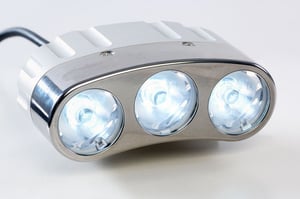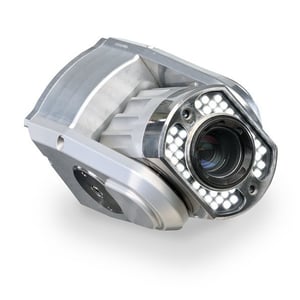Sewer inspection cameras come in all shapes and sizes, depending on their function and the type of pipe they inspect. At its most basic, a sewer inspection camera consists of a small, durable camera, lights, and some mechanism to help the camera enter a pipe and/or manhole. Sewer cameras are used to identify problems in sewers, such as blockages, pipe breaks and sewer corrosion.
Designs of Sewer Camera Equipment
To view pipes, cameras must be able to travel into them or view long distances down a line from an access point. There are several different camera designs that can accomplish this.
Crawlers are sewer cameras on wheels or tracks, which move the instrumentation through sewers. These devices transmit a real-time view from inside of a pipe to an operator aboveground and can typically crawl long distances, often more than 1000’. They are commonly used in larger, mainline sewers.
Some crawlers have lateral launch abilities and can propel a small camera attached to a cable into a lateral line from a main sewer line.
A push sewer camera is a small camera head that is fed into a lateral or drain line via a long cable. Like crawlers, push cameras collect inspection footage (photos or video) as they move through pipes.
Jetter nozzles consist of a camera housed in a sewer cleaning nozzle head. These nozzles are used to clean or “jet” sewers, which makes it easier for operators to inspect pipes for defects or other issues. Many nozzles allow operators to clean and inspect pipes at the same time, streamlining the assessment process.
Parts of A Sewer Inspection Camera
Camera
Sewer inspection equipment typically has at least one camera. Depending on the type or quality of the equipment, they may also have more, such as backup cameras on crawlers. These cameras take photos or videos inside sewers that are streamed and/or recorded for inspection operators to view above ground. Some sewer cameras are equipped with HD capabilities, wide view fish-eye lenses for side-scanning, or pan/tilt and zoom functions, making it easier for operators to get a closer look at areas of interest.
Lights

Underground infrastructure is a dark and punishing environment, so lights are an essential part of sewer inspection gear. They illuminate pipe so that sewer cameras can get a clear view inside. Invest in assessment equipment that has bright, reliable, and adjustable lighting.
Sensors
Modern sewer camera units usually have a sonde, or small radio transmitter, built in. These transmitters let operators trace the system’s location underground. The operator will steer the sewer inspection crawler or push camera head to identify a blockage or damage, then use a device to pick up the transmission signal above ground and determine the exact location.
Inspection systems may also include measurement lasers, which determine things like pipe diameter, bends and obstructions—all without confined space entry. Other common sensors can measure incline, internal system pressure and temperature.
What Are Sewer Cameras Used For?
Sewer inspections are performed as part of routine maintenance, before or after sewer cleaning, or when there is a broken pipe, blockage or sewer backup. A damaged pipe can cause untreated wastewater to flow outside of sewers, threatening the health and safety of our communities. Depending on their scale, these problems can constitute emergencies that require immediate attention.
It’s a good idea for homeowners to get their lateral lines cleaned and inspected every few years. This kind of maintenance helps prevent small issues from becoming disasters.
ROVVER X from Envirosight is the versatile, all-in-one municipal inspection crawler platform that makes sewer assessment simple. Click below to learn more about the most trusted sewer inspection camera and crawler in the industry.



